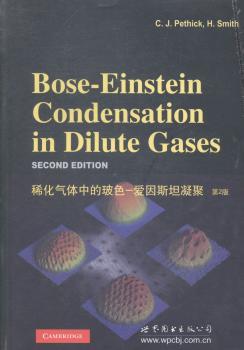内容简介
《稀化气体中的玻色:爱因斯坦凝聚(第2版)》是一部关于稀化气体中玻色—爱因斯坦凝聚的专著。早在1925年爱因斯坦便预言,气态粒子在低温下会在各方面处于同样的量子状态。《稀化气体中的玻色:爱因斯坦凝聚(第2版)》重点论述其基础物理原理。全书共14章,每章末附有问题和参考文献,书末附有基本常数和转换因数的附录。《稀化气体中的玻色:爱因斯坦凝聚(第2版)》适用于高校物理系及相关专业的教师、研究生和从事新物态及相关研究的科研工作者。
目录
Preface
1 Introduction
1.1 Bose—Einstein condensation in atomic clouds
1.2 Superfluid 4He
1.3 Other condensates
1.4 Overview
Problems
References
2 The non—interacting Bose gas
2.1 The Bose distribution
2.1.1 Density of states
2.2 Transition temperature and condensate fraction
2.2.1 Condensate fraction
2.3 Density profile and velocity distribution
2.3.1 The semi—classical distribution
2.4 Thermodynamic quantities
2.4.1 Condensed phase
2.4.2 Normal phase
2.4.3 Specific heat close to Tc
2.5 Effect of finite particle number
Problems
References
3 Atomic properties
3.1 Atomic structure
3.2 The Zeeman effect
3.3 Response to an electric field
3.4 Energy scales
Problems
References
4 Trapping and cooling of atoms
4.1 Magnetic traps
4.1.1 The quadrupole trap
4.1.2 The TOP trap
4.1.3 Magnetic bottles and the Ioffe—Pritchard trap
4.1.4 Microtraps
4.2 Influence of laser light on an atom
4.2.1 Forces on an atom in a laser field
4.2.2 Optical traps
4.3 Laser cooling: the Doppler process
4.4 The magneto—optical trap
4.5 Sisyphus cooling
4.6 Evaporative cooling
4.7 Spin—polarized hydrogen
Problems
References
5 Interactions between atoms
5.1 Interatomic potentials and the van der Waals interaction
5.2 Basic scattering theory
5.2.1 Effective interactions and the scattering length
5.3 Scattering length for a model potential
5.4 Scattering between different internal states
5.4.1 Inelastic processes
5.4.2 Elastic scattering and Feshbach resonances
5.5 Determination of scattering lengths
5.5.1 Scattering lengths for alkali atoms and hydrogen
Problems
References
6 Theory of the condensed state
6.1 The Gross—Pitaevskii equation
6.2 The ground state for trapped bosons
6.2.1 A variational calculation
6.2.2 The Thomas—Fermi approximation
6.3 Surface structure of clouds
6.4 Healing of the condensate wave function
6.5 Condensates with dipolar interactions
Problems
References
7 Dynamics of the condensate
7.1 General formulation
7.1.1 The hydrodynamic equations
7.2 Elementary excitations
7.3 Collective modes in traps
7.3.1 Traps with spherical symmetry
7.3.2 Anisotropic traps
7.3.3 Collective coordinates and the variational method
7.4 Surface modes
7.5 Free expansion of the condensate
7.6 Solitons
7.6.1 Dark solitons
7.6.2




 VIP会员
VIP会员